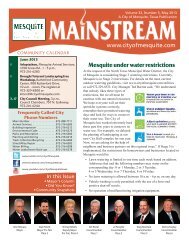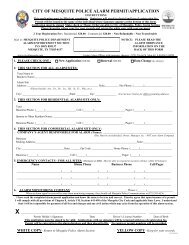airport/documents/Mesquite Master Plan Final.pdf - The City of ...
airport/documents/Mesquite Master Plan Final.pdf - The City of ...
airport/documents/Mesquite Master Plan Final.pdf - The City of ...
You also want an ePaper? Increase the reach of your titles
YUMPU automatically turns print PDFs into web optimized ePapers that Google loves.
periods <strong>of</strong> poor visibility. <strong>Mesquite</strong><br />
Metro Airport has one published ILS<br />
approach to Runway 17.<br />
ILS systems provide three functions: 1)<br />
guidance, provided vertically by a glide<br />
slope beacon and horizontally by a<br />
localizer beacon; 2) range, furnished by<br />
marker beacons; and 3) visual<br />
alignment, supplied by the approach<br />
lighting system and runway edge lights.<br />
<strong>The</strong> localizer antenna for Runway 17 is<br />
situated on the extended centerline,<br />
approximately 1,800 feet south <strong>of</strong> the<br />
Runway 35 threshold. <strong>The</strong> antenna<br />
emits very high frequency (VHF)<br />
signals that provide the pilot with<br />
course deviation left or right <strong>of</strong> the<br />
runway centerline and the degree <strong>of</strong><br />
deviation. <strong>The</strong> ultra high frequency<br />
(UHF) glide slope (GS) antenna is<br />
located on the northeast side <strong>of</strong> the<br />
runway, approximately 1,100 feet<br />
southwest <strong>of</strong> the Runway 17 landing<br />
threshold. <strong>The</strong> glide slope antenna<br />
provides a signal indicating whether the<br />
aircraft is above or below the desired<br />
glide path. <strong>The</strong> ILS equipment is<br />
owned and maintained by the <strong>City</strong> <strong>of</strong><br />
<strong>Mesquite</strong>.<br />
To further assist the ILS approach, an<br />
initial approach fix is established by an<br />
outer marker (<strong>Mesquite</strong> NDB). <strong>The</strong><br />
Runway 17 ILS approach has a 3.0<br />
degree glide slope that intercepts initial<br />
approach fix at a distance <strong>of</strong> 3.2<br />
nautical miles and 1,600 feet above the<br />
threshold. It should be noted that the<br />
ILS Runway 17 approach requires<br />
aircraft not only to be equipped with<br />
ILS receivers, but also automatic<br />
direction finding (ADF) equipment.<br />
1-14<br />
Area Airspace<br />
<strong>The</strong> FAA Act <strong>of</strong> 1958 established the<br />
FAA as the responsible agency for the<br />
control and use <strong>of</strong> navigable airspace<br />
within the United States. <strong>The</strong> FAA has<br />
established the National Airspace<br />
System (NAS) to protect persons and<br />
property on the ground and to establish<br />
a safe environment for civil,<br />
commercial, and military aviation. <strong>The</strong><br />
NAS is defined as the common network<br />
<strong>of</strong> U.S. airspace, including air<br />
navigational facilities; <strong>airport</strong>s and<br />
landing areas; aeronautical charts;<br />
associated rules, regulations and<br />
procedures; technical information; and<br />
personnel and material. System<br />
components shared jointly with the<br />
military are also included as part <strong>of</strong> this<br />
system.<br />
To ensure a safe and efficient airspace<br />
environment for all aspects <strong>of</strong> aviation,<br />
the FAA has established an airspace<br />
structure that regulates and establishes<br />
procedures for aircraft using the<br />
National Airspace System. <strong>The</strong> U.S.<br />
airspace structure provides for<br />
categories <strong>of</strong> airspace, controlled and<br />
uncontrolled, and identifies them as<br />
Classes A, B, C, D, E, and G, as<br />
described below. Exhibit 1E generally<br />
illustrates each airspace type in threedimensional<br />
form.<br />
• Class A airspace is controlled<br />
airspace and includes all airspace<br />
from 18,000 feet mean sea level<br />
(MSL) to Flight Level 600<br />
(approximately 60,000 feet MSL).<br />
• Class B airspace is controlled<br />
airspace surrounding high-activity<br />
commercial service <strong>airport</strong>s (i.e.,




